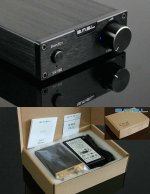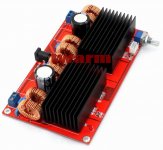The circuit appears to be similar to the one Buehgemeiste has drawn below, with the exception that the 2.2R does not connect to ground
...maybe i saw and draw it wrong.
i might disassemble my blown up board and take a look at the traces beneath that big resistor again.
xrk, which SMPS 24V brick you're using?
I've got a couple of 7498 boards, and power supply is a pain 🙁
24v 5amp brick from Amazon for $18, not too bad.
http://www.amazon.com/BINZET-Supply...sim_147_3?ie=UTF8&refRID=0C2494B7WK4J8MW2JYMR
or
http://www.amazon.com/SUPERNIGHT-10...pebp=1435600611412&perid=15ZJRCMN99XDJQPYJ99F
I am not using this one but one I happened to have on hand (for a home in-wall audio system controller) that is only 2 amps. But for testing it serves to provide higher voltages but not peak load.
Were you close to board when electrolytic blew? Was it mild pop open or full explosion?
i was in the same room.
it was no explosion.
the amp failed to produce music.
the cap opened up on its top and bubbles were coming out of it.
i disconnected the power supply and increased the distance between me and the amp.
when everything was soft-boiled i checked the situation.
the cap wasn't fully blown up, just the predetermined breaking point cracked up and some bubbles of electrolyte found their way out od it.
i found obviously completely blown electros in failed electronic equipment before.
but that was the only time i saw how it happened.
You intended 36/38V didn't you? To have more power than 3116.
I thought 32v is max, at least that's what is labeled on the PCB. Anyhow, if 38v is allowable I will use two 19v x 4.75amp SMPS bricks in series and get my cheap thrills that way for $12.
Once you go above 24v, SMPS bricks are hard to come by. Years ago, I had these Dell mini desktops, the SX280 USFF series I think. I had a bank of 8 of them for a parallel computer cluster via Gbit Ethernet. They had massive external SMPS bricks capable of 15 amps - put three of those 12v bricks in series and you have a monster 36v power supply with 15 amps. I think the only thing needed is a blocking diode between supplies to prevent reverse flow during turn on transients. Wish I kept those supplies rather than getting rid of them.
Last edited:
look at this.
a tda7498 mono board popped up.
i wonder if it is 7498E.
Versandkostenfrei tda7498 150w*1 class d verstrker brett mit hoher endstufe bord wollen gute Qualitt, bitte whlen Sie uns in Tda7498 150w*1 class d verstrker brett mit hoher endstufe bord wollen gute Qualitt, bitte whlen Sie uns aus Verstrk
a tda7498 mono board popped up.
i wonder if it is 7498E.
Versandkostenfrei tda7498 150w*1 class d verstrker brett mit hoher endstufe bord wollen gute Qualitt, bitte whlen Sie uns in Tda7498 150w*1 class d verstrker brett mit hoher endstufe bord wollen gute Qualitt, bitte whlen Sie uns aus Verstrk
I finally had time to test all the recent cheap amps that have arrived from Aliexpress and Amazon. I set up my 0.53x Karlsonator speakers fitted with Dayton 5in PA120-8 pro audio full range drivers. I found several power supplies for all the different amps: 12v, 19v, 24v, and made a 3-pin header to 3.5mm stereo jack. Set them all up side by side and listened to them one after another.
Amps included:
qnty 2 x TDA7498 (black heatsinks)
qnty 1 x fake YJ blueblack (Danzz) TPA3116D2
qnty 1 x SMAKN TPA3116D2
qnty 2 x 'lunch money' TDA7297 class AB
Here are TDA7498's and fake YJ blueblack:
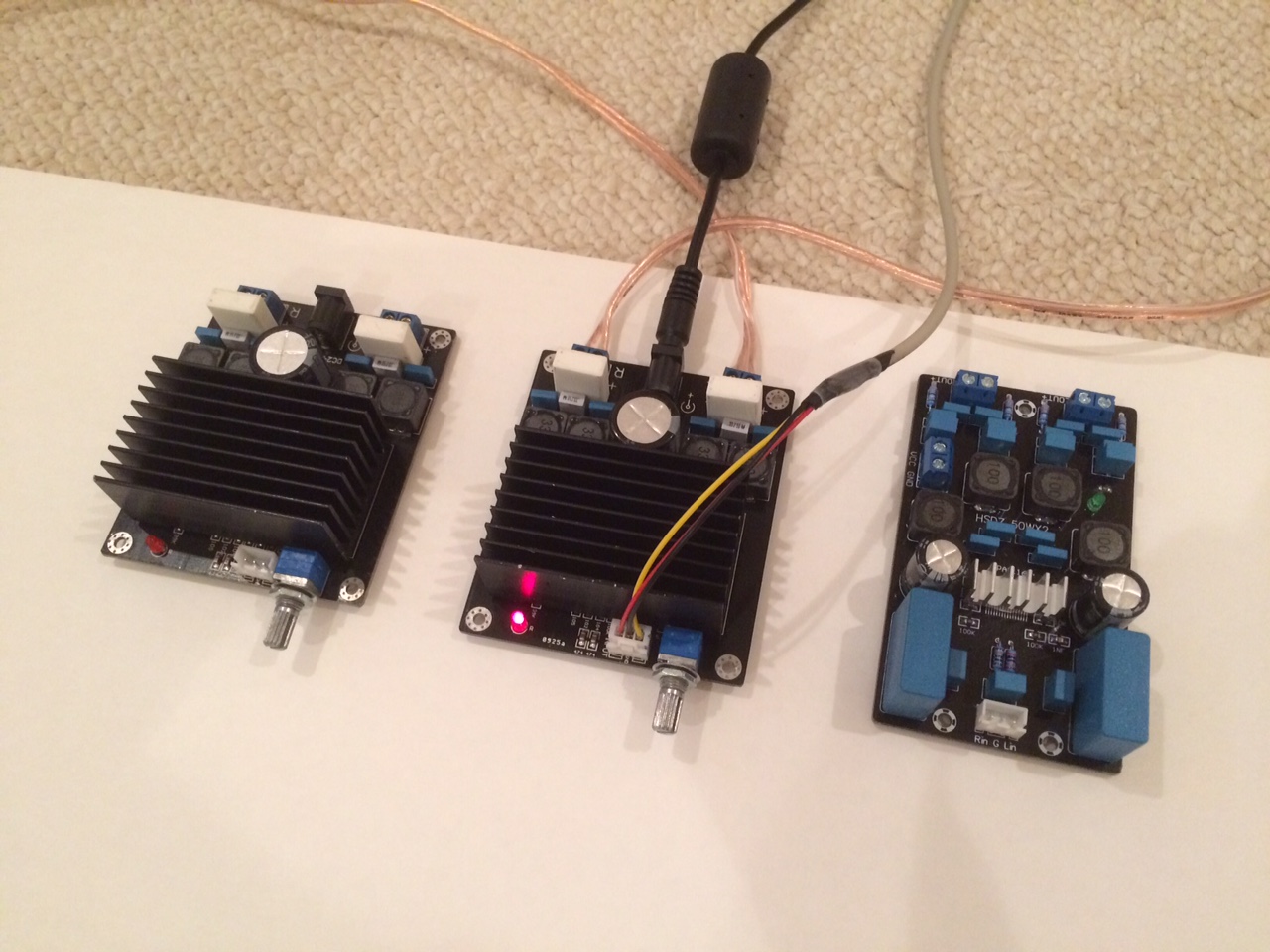
Here is the whole lot with SMAKN currently under test (note assortment of power leads and audio input leads):
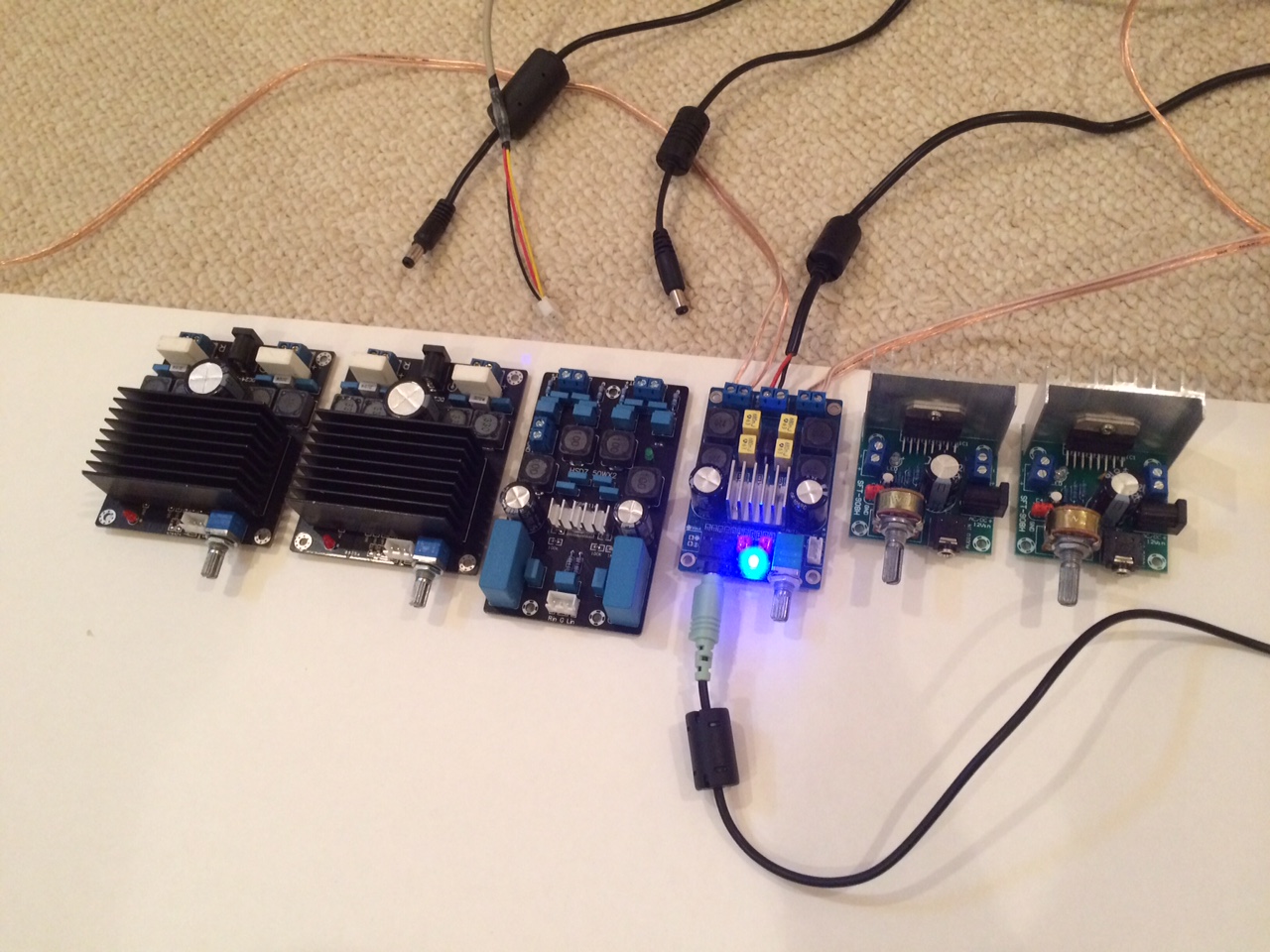
First thing I noticed was the amazing stereo phantom image I can get from full range drivers. No XO to muck with the phase so sound stage is very clearly defined.
Main purpose was to test overall sound and whether or not they are DOA.
They all sound very nice, with the cheap TDA7498's of course, being able to pack a real punch. The bad thing with the 7498's is that the speaker polarity is mis-labeled. If you connect as shown (R) -/+ and (L) -/+ you immediately hear that wierd phasiness. I swapped the (R) to +/- and immediately it improved and sounded normal. I also took a frequency spectrum to make sure bass wasn't cancelling and it's all good.
The SMAKN sounded really nice - musical and clear. The extra gain required turning the volume down.
The fake YJ blueblack was actually also decent sounding - did not detect any issues like Lo Tse had with his not sounding good.
The little $5 TDA7297's were surprisingly clear sounding, not as loud but for their range, quite formidable. I would almost want to try these to power the tweeters for my next project.
Good fun testing. The neat thing about using a full range speaker is that the step response and impulse response are magical. Drum solos have great realism due to timing accuracy.
xrk,
Ya man, looking good!! You are the "king of the cheap amps"!!
I totally agree with you, these amps are so inexpensive but brought a lot of fun. Ever since I killed the Audiobah green boards, I have been using the exact same SAMKN amp board and have no complaints. I use the small chip amps to drive my 88 dB Von Schweirkert VR4 and enjoy the sound. However, I am still using my Bryston to work with the 84 dB Eminent Tech LFT-8BII planar magnetic. I ordered a 7498 board which I hope will arrive soon. Will provide some comments (as compare to the 3116) once I have a listen. I think I have the same "YJ black" as yours. It has no operation problem. Just sounded really flat - originally I want to mod this board, but after he initial impression, I lost interest.
Regards,
I really like the TDA7498's and after hearing from those who studied its internal wiring - it appears to have an advantage with a fixed 60k input impedance regardless of gain setting due to built in buffer. I also like how it has a built in symmetric Zobel to reduce oscillations between the two LC legs. They run cool to the touch and when given a big power supply can pack a real punch. No complaints and in fact the best $11 ever spent on an amp. I am going to hook them up to my all horn loaded synergy and FLH bass horn ref system now.
Sweet, that amp looks like it may fare well enough with my small 8" horn sub. I need to get rid of my awful plate amp I got salvaged from and old Acoustic Research sub.
TDA7498 works well with miniDSP
This setup works really well with my 3-way synergy and bass horn reference speaker. The bass/sub is dual channel so I use all 4 amp channels.
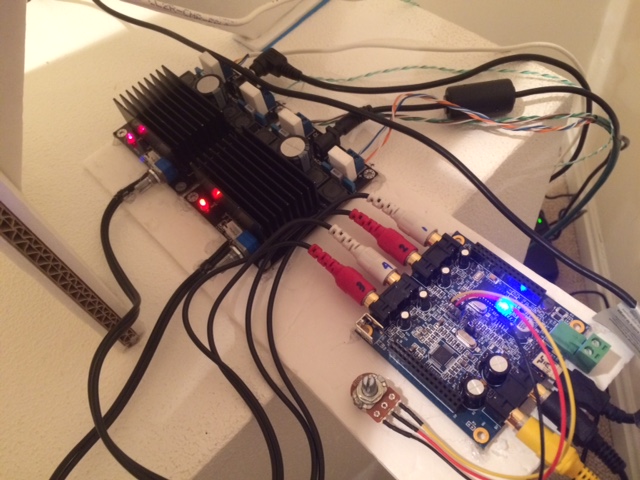
$11 on Aliexpress:
http://www.aliexpress.com/item/TDA7...369235748.html?spm=2114.32010308.4.132.0172up
Just ordered 2 more...
This setup works really well with my 3-way synergy and bass horn reference speaker. The bass/sub is dual channel so I use all 4 amp channels.

$11 on Aliexpress:
http://www.aliexpress.com/item/TDA7...369235748.html?spm=2114.32010308.4.132.0172up
Just ordered 2 more...
Attachments
Last edited:
I found a TDA7492E amp, with enclosure, and 32V power for about $87.
It's rated at 160W + 160W.
Looks good!
Nice find! SMSL makes nice finished amps so I think this one is probably a winner. Looks like the 7292E is rated even higher power.
Those little square blue plastic stereo pots that come with some of the boards work very well. No scratchy noises. I would just pick a board that has it. If you bought your own from Newark or Mouser it will probably cost almost as much as a complete amp board. 🙂
I don't know who makes those pots but they work well.
I don't know who makes those pots but they work well.
Yeah I already have this sitting on my work bench
TDA7492 D Class High Power Digital Amplifier Board 2X50W Amp Board with Radia | eBay
So I need to buy an external pot, just wondering is 50k ok?
Thanks
TDA7492 D Class High Power Digital Amplifier Board 2X50W Amp Board with Radia | eBay
So I need to buy an external pot, just wondering is 50k ok?
Thanks
Last edited:
In lay terms, what is it about these chip amps that allow them to get by with such modest power supply requirements? For y'all EE's this must seem silly and trifling. But dynamic headroom, transient demands, damping factor, all being managed by a chip with a mere 5A laptop power supply makes me smile and shake my head.
But I am following this thread and find myself pleasantly amused. I went ahead and ordered a power supply and an amplifier board and look forward to playing with one of these real soon.
That said, I just turned on a diminutive Yamaha M-45 (AKA real amplifier) and the lights dimmed in the bedroom. It never comes out of Class A driving FE-103's to very satisfying levels.
I built and modified some amps with cave man knowledge and a soldering iron back when the surplus market was flooded with high voltage power supply capacitors and one could build multi-Farad banks of grapefruit can sized caps for very little. (Many an inquisitive cat was fried, may they RIP.)
What dark magic allows these chip amps this much control with so little observable power?
But I am following this thread and find myself pleasantly amused. I went ahead and ordered a power supply and an amplifier board and look forward to playing with one of these real soon.
That said, I just turned on a diminutive Yamaha M-45 (AKA real amplifier) and the lights dimmed in the bedroom. It never comes out of Class A driving FE-103's to very satisfying levels.
I built and modified some amps with cave man knowledge and a soldering iron back when the surplus market was flooded with high voltage power supply capacitors and one could build multi-Farad banks of grapefruit can sized caps for very little. (Many an inquisitive cat was fried, may they RIP.)
What dark magic allows these chip amps this much control with so little observable power?
- Home
- Amplifiers
- Class D
- TDA7492 Amp

